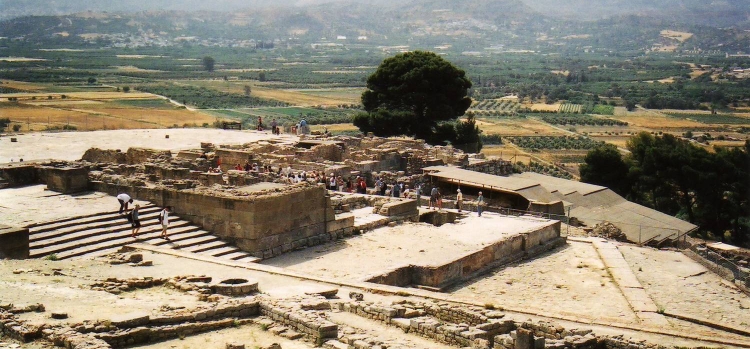Faistos
Phaistos is located 62 km south of Iraklion and, administratively, is part of the Municipality of Kamilari. It was the second biggest city of the Minoan Crete and it is built on a hill, at an altitude of 100 m from sea level, in the fertile valley of Messara.
The valley is surrounded by mountain ranges and in the south extends the Libyan Sea.
You can access Phaistos from Iraklion taking the road to Moires- Timbaki, an asphalt road of fairly good condition with a panoramic view to the Messara valley. The site can be accessed also from the south.
Regular public transportation is available from Iraklion and Rethimnon.
Ariving at Phaistos you will find a large parking area in a few distance from the palace. You have to walk for a while through a paved road until the entrance of the archaeological site where there is a restaurant- bar and shops with post-cards, guide-books, maps etc. for the visitors.
The exact location of Phaistos was first determined in the middle of the 19th century by the British admiral Spratt, while the archaeological investigation of the palace started in 1884 by the Italians F. Halbherr and A. Taramelli. After the declaration of the independent Cretan State in 1898, excavations were carried out by F. Halbherr and L. Pernier in 1900-1904 and later, in 1950-1971, by Doro Levi, under the auspices of the Italian Archaeological School at Athens.
Although many inscriptions were found by the archaeologists, they are all in Linear A code which is still undecipherd, and all we know about the site, even its name are based to the ancient writers and findings from Knossos.
According to mythology, Phaistos was the seat of king Radamanthis, brother of king Minos. It was also the city that gave birth to the great wise man and soothsayer Epimenidis, one of the seven wise men of the ancient world.
Excavations by archaeologists have unearthed ruins of the Neolithic times (3.000 B.C.).During the Minoan times, Phaistos was a very important city-state. Its dominion, at its peak, stretched from Lithinon to Psychion and included the Paximadia islands. The city participated to the Trojan war and later became one of the most important cities-states of the Dorian period.Phaistos continued to flourish during Archaic, Classical and Hellenistic times. It was destroyed by the Gortynians during the 3rd century B.C. In spite of that, Phaistos continued to exist during the Roman period.
Phaistos had two ports, Matala and Kommos.
Since 1900, continuous archaeological excavations from the Italian Archaeological School, have brought to light the magnificent Minoan palace of Phaistos with its great royal courts, the great staircases, the theatre, the storerooms and the famous disk of Phaistos.
The first palace was built at 2.000 B.C. This palace was destroyed at 1.700 B.C. by an earthquake. It was built again, more luxurious and magnificent and it was destroyed again, probably by another earthquake, at 1.400 B.C.
The location of the palace was carefully chosen, so as not only to absolutely control the valley of Messara, but to also offer a panoramic view of the surrounding area with the scattered villages, just like today, at the foot of the mountains Psiloritis and Asterousia.
The palace dominated and controlled the Messara valley and it was the center of the city. It was the administrational and economical center of the area.
Goods not only for consumption but mainly for trade were kept in its huge storerooms. The palace was surrounded by luxurious mansions and crowded urban communities. Along with the surrounding settlements covered an area of 18.000 sq. meters.
A paved road leads to the ruins of the Royal Minoan villa of Agia Triada, 3 km west of Phaistos.
Share this article



